Standard RV mattresses are not famous for their plushness or comfort. But luckily, you can create your own mix of mattresses and toppers to have that perfect sleeping experience in an RV. There are numerous options out there.
You might even be tempted to use that favorite mattress from your bedroom. In our RV mattress ideas, tips and tricks article, we will outline the various ways in which you can replace or improve your RV mattress for the better.
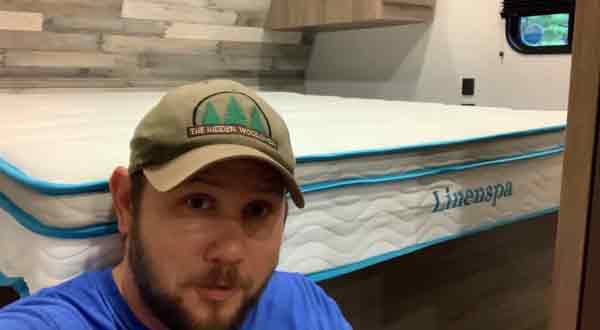
Use A Regular Bed Mattress As An RV Mattress?
This is not recommended, for obvious reasons. Space is at a premium in all RVs and campers. Regular mattresses may not necessarily have the perfect fit for these spaces.
Standard sizes are not applicable to RV mattresses. But if the mattress space inside your camper or RV fits a regular mattress, you can use it of course.
5 RV Mattress Ideas You Can Use
RV mattresses are available in a wide range of materials and configurations. It is important to look at several factors before picking a new mattress for your RV. Are you still considering repurposing a regular mattress? In the following sections, we will carefully examine some of the vital factors that might stand in your way.
1. Mattress Shape
The sleeping areas in RVs tend to have a unique shape. Often, RV mattresses look as if they are regular mattresses with a few corners cut off to save on space. Sometimes, depending on the indoor layout of your RV, they may have contours or specific shapes you never see in regular mattresses.
2. Mattress Size
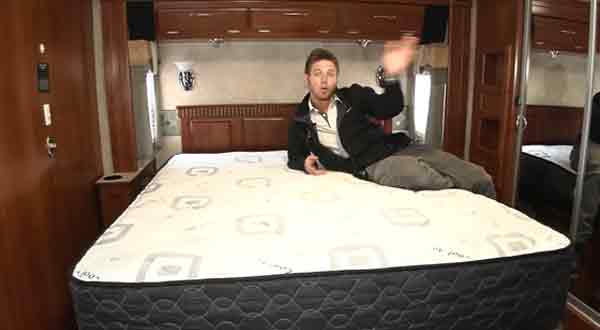
Much more than shape, size is often the limiting factor when it comes to picking the right mattress for your RV or camper. Consider standard home mattresses for instance. They are available in well-known size configurations like Twin, Full, Queen, King, and California King. In all, there are less than a dozen standardized sizes for these mattresses.
In stark contrast, most RV mattresses do not follow any strict measurement standards. This is especially true in the case of cut-corner mattresses. So what do you do? Well, the best thing is to measure your mattress space and make a custom order.
3. Camper Mattress Thickness
RVs usually prefer low-profile mattresses. A massive 10 or 12-inch thick mattress will probably stick out inside these spaces. Think pop up trailers and bunk beds for instance.
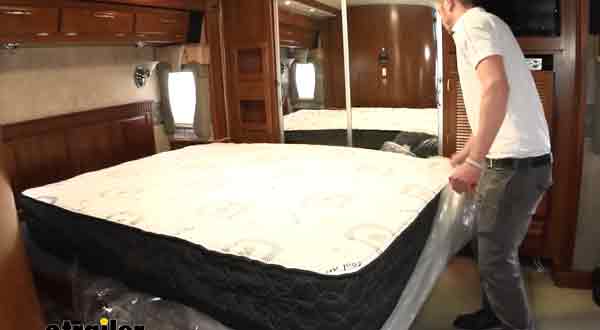
They can only handle thinner mattresses, not those ten inch thick comfy beds. Remember, when measuring for camper beds, you have to measure the vertical space available as well, not just the length and breadth.
4. Mattress Weight
As you very well know, RVs run on gas. And every extra pound you load on to the vehicle will reduce your mileage and increase your running costs. Think about the average weight of that mattress in your bedroom. Even the smaller twin sized version weighs more than 50lbs.
And those massive kings can exceed a whopping 180lbs. So most RVs are furnished with lighter mattresses made from materials like foam. They will not have any metallic springs, as those can increase the weight drastically. And they also work better in cramped spaces, as you can roll them up with ease.
5. Motorhome Mattress Characteristics
Mattresses in an RV have to face stress and pressures that are never experienced by the mattress in your bedroom. An RV is constantly in motion and will experience severe fluctuations in temperature. Standard mattresses are more used to comfortable homes with thermostats and ACs.
An RV mattress is made up of more robust materials that can withstand the rigors of constant travel and exposure to the elements. Standard memory foam mattresses cannot hold up in such trying conditions. They will usually deteriorate when subjected to extreme temperatures.
But ordinary foam is another breed altogether. It is not as fragile as memory foam. It is sturdy, fire retardant, and resistant to mold and mildew as well. RVs are particularly vulnerable to mold, as they have less ventilation than regular homes.
A typical high-quality RV mattress is designed and tested to withstand rough use as well as long periods of storage. It is often during storage that a lot of degradation and damage takes place. Regular mattresses are simply not built to cope with that.
5 Ways To Make The RV Bed More Comfortable
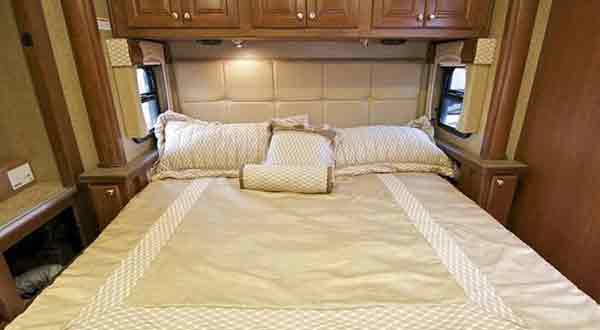
But the job doesn't end when you choose the right RV mattress. Unless it is properly equipped with the right accessories, you will not feel comfortable. Nobody wants to wake up in an RV and feel like they have been sleeping on a bed of rocks! Here are some tips to make your RV mattress more comfortable.
1. Feather Bed Topper
RV mattresses are not famous for their plush feel. A thick layer of feathers beneath a mattress pad can change things drastically. If you are allergic to feathers, a thick quilted mattress pad is an equally viable alternative. Just make sure that you have the correct measurements when you order either one of these.
2. Pillow-Top Topper
Add this accessory as an extra layer over your RV mattress. Look for toppers made from cotton. A thick layer of hypoallergenic fiber inside will you give you additional support and comfort. Specialty stores for camping goods and RV supplies often sell these mattress accessories.
3. Air Mattress
This less an accessory, and more of a total replacement for your existing RV mattress. A majority of RV beds are odd sized, but you can also find twin, full, or even queen-sized beds (in larger RVs). Get cheap air mattresses from superstores to replace those uncomfortable mattresses. To add insulation and protection, you can add a soft blanket beneath the mattress.
4. Latex Mattress Or Topper
This is another excellent replacement option if your RV bed is really hard and uncomfortable. Latex mattresses are incredibly expensive for regular beds, and the same rule also applies for RVs. If you can afford it, a thick, 6-inch RV latex mattress will take care of all your RV sleeping troubles. But if that is too expensive, you can always find a more affordable topper made from latex foam.
5. Merino Wool Topper
Merino wool is a high-quality organic option but comes with some maintenance requirements. It cannot be machine washed. Your only option is to do some spot cleaning with mild detergents. And these toppers should also be aired frequently in the sun. But if you can find one with a soft cotton cover, they can make your RV bed feel heavenly.
5. Memory Foam Or Egg-Crate
As we already mentioned, memory foam cannot handle wild temperature fluctuations. So keep that in mind while putting your RV in storage for an extended period. Memory foam RV beds are available in relatively thinner configuration, with 2-4 inches being standard. You might want to add plush quilts to make these beds more comfortable.
6 Tips For Making Your RV's Bed
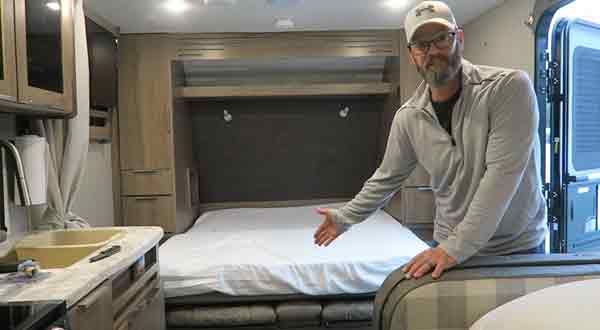
Once you have created the perfect RV mattress bed with the components mentioned above, it is time to learn about maintenance. Just like at home, you have to regularly "make" your RV beds. It is no easy task when you consider those cramped spaces and bunk structures. Here are some RV mattress tips to make this chore easier for you:
1. Layer Sheets
If you have a little one in your party with a penchant for bedwetting, this is the perfect solution for that! It is also useful for dealing with the beds of adults as well. Instead of using just one sheet, use several on each RV bed. The lower layers will stay clean and can be used without fuss if the top layer gets dirty. For the bedwetter, add a waterproof layer after the top sheet for extra protection.
2. Use A Dowel Rod Or Ruler.
Tucking the excess sheets and comforters inside can be frustrating when you are dealing with tight corners. If you are up against the wall (literally), consider using a dowel rod to tuck the sheets in between the mattress and wall. You can even use a ruler, or anything similar as long as your fingers are spared!
3. Make Bunk Mattress Cases.
Bunks beds make your life extra hard on an RV. If you want to put sheets on these, you will have to remove the mattress from the base, every time. Wild sleepers will make you go crazy with the mess they create every morning. Instead of draping these bunks with sheets, just make a giant pillowcase for your bunk bed mattresses. Use your sewing skills to get this done for more DIY points.
4. Add Some Tiles
Many RVs have plywood platforms for beds, often unfinished. They will snag onto your mattress if you try to push them out of the way for making your bed every day. You can avoid this by placing some smooth tiles between your mattress and the plywood base. Use peel and stick tiles for this purpose.
5. Switch To A Foam Mattress
RV memory foam mattresses are easier to make than regular RV mattresses. You can easily lift these lightweight mattressed and roll them away when you have to place the fresh sheets underneath them.
6. Zippered Bedding
Beds require regular maintenance. Sleeping bags are easy to maintain, but not as comfortable. So how about a product that combines the best of both these worlds?
That is what zippered bedding is all about. It is like a massive sleeping bag, for your RV bed. It is easy to maintain and easy to clean, as it has zippers on both sides. Replacing the sheets inside is child's play.
There is no single trick to creating the ideal RV bed. It all boils down to personal preferences and the sleep area layout of your RV or camper. But with our comprehensive RV mattress ideas, tips, and tricks guide, you now have a good grip on the basics and even some advanced maintenance hacks!
Hope you enjoyed this article. If you have any suggestions, queries, or requests, you can use the comments section to reach out to us. We will reply to you at the earliest. Thanks for visiting, and have fun RVing!
Leave a Reply